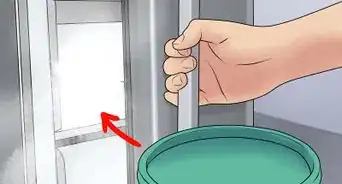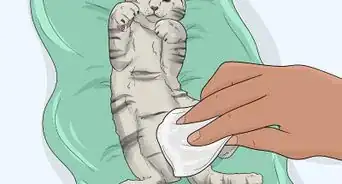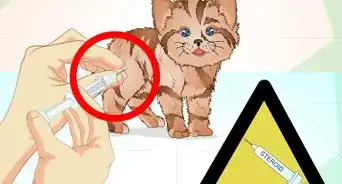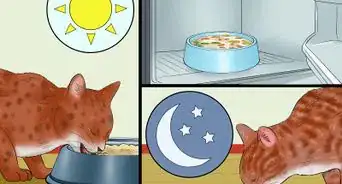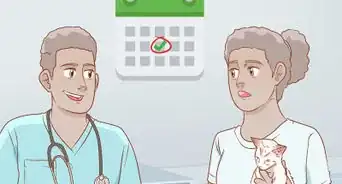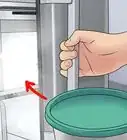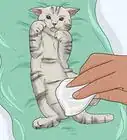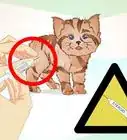This article was co-authored by Lauren Baker, DVM, PhD. Dr. Lauren Baker is a Veterinarian and Assistant Scientist at the University of Wisconsin-Madison. With over 10 years in veterinary medicine, she specializes in the concept of “one health,” which uses insights from veterinary medicine to help human medical research. She holds a Ph.D. in Comparative Biomedical Sciences, a Doctor of Veterinary Medicine, an MS in Comparative Biomedical Sciences, and a Bachelor’s degree in Psychology from the University of Wisconsin-Madison.
There are 10 references cited in this article, which can be found at the bottom of the page.
This article has been viewed 14,236 times.
If you're like a growing number of cat parents, you care about what you feed your furry friend. Proper nutrition is important to your cat's growth, current health, and prevention of future illnesses. To make sure your cat gets the nutrients they need, you have to know how to read the labels on cat food. Each country regulates labels differently. However, you can become a pro at reading labels by mastering the label terminology, assessing the food's nutritional content, and assessing claims concerning special dietary needs.
Steps
Mastering the Label Terminology
-
1Look for net weight. In the U.S., many brands abbreviate this as “NET WT” and list it at the bottom of the front of the bag or can. This is the weight of the contents of the package. For example, a net weight of 3 oz. (85 g) means the package contains three ounces/85 grams of food. This does not include the weight of the paper or metal in the package.[1]
-
2Read the statement of purpose. Look for the words, “for cats” somewhere in the statement. This informs you that the food contains ingredients that satisfy feline nutritional needs. You should find this statement on the front of the package.
- Make sure the statement fits your cat's stage of life. If you have a kitten (under the age of one) or a senior cat (over the age of 12), make sure the statement includes “kittens” or “senior cats.” Apply the same rules for pregnant and nursing cats. These stages have different nutritional requirements than adult cats who are not pregnant or nursing.[2]
Advertisement -
3Assess the guaranteed analysis. Under U.S. law, this list must include the minimum and maximum percentages of crude protein (an analysis of nitrogen in plant and animal protein sources), crude fat (the amount of fat calories about to be burned), crude fiber (fiber that doesn't absorb water), and moisture.
- For example, if you read “Crude Protein (Min.) 10.0%,” this means that crude protein is at least 10 percent of the net weight. It could contain more. An analysis of “Crude Fiber (Max) 1.5%” means that crude fiber is no more than 1.5 percent of the net weight, although it could contain less.
- Some brands might include ash (the final product after food has been completely incinerated). This is a voluntary move on the part of the manufacturer. U.S. law does not require its inclusion in the analysis. Look for this information on the back of the package. It usually appears above the ingredient list.[3]
-
4Read the feeding instructions. You can find this information on the back of the package, usually under the ingredients and in bold font. These are more like guidelines, as opposed to strict directions. Because each cat is different, ask your vet for specific feeding instructions.[4]
- For example, the instructions might read, “Feed an average size adult cat 1 can per 2.5 pounds of body weight daily. Feed up to twice this amount for kittens.” If your adult cat weighs 10 pounds, the manufacturer recommends feeding them four cans per day. For a three-pound kitten, the guideline would be about two cans per day.
-
5Look for the statement of responsibility. You can find this on the back of the label under the list of ingredients. This statement gives the full name of the manufacturer and their contact information. Usually, the contact info will include a mailing address and a toll-free telephone number. It also contains a statement of their obligation to meet nutritional standards established by the Association of American Feed Control Officials (AAFCO) or its non-U.S. equivalent.[5]
Decoding Product Name Rules
-
1Note the placement of ingredients in the product name. The AAFCO mandates that product names comply with one of four rules. Each rule governs what cat food must contain in order to legally have certain names. If you live outside the U.S., check the rules established by your national equivalent of the AAFCO.[6]
-
2Recognize the 95-Percent Rule. This usually applies to foods with simple names and few ingredients. The ingredient in the product name must be at least 95 percent of the net weight, not counting the ingredient's water content. The water content is capped at 25 percent of the ingredient.
- For example, a 6-oz. can of “Tuna Cat Food” can't contain more than 1.5 oz. of water. Its tuna content must come to at least 4.5 oz.[7]
-
3Grasp the 25-Percent Rule (aka the “Dinner Rule”). Any product name containing a main ingredient that comes to less than 95 percent but at least 25 percent of the net weight must include the word “dinner” somewhere in the name. Its water content can't be more than 15 percent of the main ingredient.
- For example, a 6-oz. can of “Tuna Dinner for Cats” shouldn't contain more than 0.9 oz. of water. Its tuna content must weigh between 1.28 oz and 5.1 oz.[8]
-
4Decode the "Dinner Rule" with more than one ingredient. The total of the named ingredients must equal 25 percent of the net weight. At the same time, each ingredient must be at least 3 percent of the net weight. The manufacturer must list the ingredients in the same order as they appear in the ingredients list.
- For example, a 6-oz. can of “Tuna, Chicken, and Shrimp Dinner for Cats” must include at least 0.18 oz each of tuna, chicken, and shrimp. The three ingredients must total at least 1.5 oz. Tuna must be the most common ingredient, followed by chicken and shrimp.[9]
-
5Recognize the 3-Percent Rule (aka the “With Rule”). If the product name includes “with,” at least 3 percent of its content must be that ingredient. For example, a 6-oz. can of cat food labeled “Turkey with Cheddar” must contain at least 0.18 oz. of Cheddar cheese.[10]
Assessing the Nutrition Content
-
1Read the first three ingredients. Pet food labels list ingredients by weight in decreasing order. Although cats can have some vegetables, they haven't evolved to tolerate vegetarian or vegan diets.[11] For this reason, you should make sure the first three ingredients are always meat (includes poultry, lamb, and fish) or meat meal.[12] Avoid any foods whose top three ingredients include grains (such as corn or wheat) and/or gluten.[13]
- Meat is animal flesh, muscle, esophagi, hearts, and lungs. Meal is finely ground dehydrated tissue. Meat weighs more because of its water and fat contents. However, meat meal is higher in minerals and protein.[14]
- Meat and meat meal are especially crucial for diabetic cats. If you buy food containing gravy or any grains, they should appear toward the end of the ingredient list. No more than 10 percent of your cat's calories should come from carbohydrates.[15]
-
2Pay attention to the nutrients. Nutrients are more important than the ingredients. Cats need a variety of nutrients to survive. These include amino acids, vitamins (especially B vitamins), water, and fiber. Make sure the food contains more amino acids and B vitamins than fiber and other carbohydrates. Nutrient requirements change throughout a cat's life. Check with your vet for specific recommendations.
- The amino acid taurine is one of the most essential nutrients for cats' vision and heart health. They literally need it to stay alive. While taurine doesn't have to be among the first three ingredients, the farther up in the list of ingredients it appears, the better.[16]
-
3Read the calorie content. Cats' daily caloric needs vary depending on their weight or stage of life. Often, calories are listed as kilocalories or “kcal.” This means the same thing as “calories” on human food labels. This information is usually listed on the back of the package below the feeding instructions. In the U.S., manufacturers must include the calories per kilogram of net weight in kilograms followed by a “translation” of the number of calories per can.[17]
- An example of this information might look like this: “Calorie Content (Calculated) 853 kcal/kg 73 kcal/can.”
- The calorie content of the food must be balanced with its nutrient content. However, manufacturers in the U.S. are not required to list a breakdown of percentages of each nutrient per calorie. If you can't find an itemized list, contact the manufacturer for more information.[18]
Assessing Special Dietary Needs
-
1Look for allergy information. If your cat suffers from food allergies, it's important to buy food that doesn't contain certain ingredients. Although human food in the U.S. must include allergy information on labels, this isn't the case with pet food. However, if your cat has allergies to certain ingredients such as fish, you'll have to scan the ingredient list on the back.[19]
- Even if the ingredient your cat is allergic to is not on the label, this doesn't guarantee the diet was produced in an allergen-free facility or processed on the same equipment.
- If your cat has a food allergy, consider a diet specifically formulated for cats with allergies. These diets are specially processed to break down proteins in the food so that they're too small to cause an allergic reaction. Talk to your veterinarian for a prescription.
-
2Don't mistake “Grain-Free” for carb-free. This is especially important if your cat has diabetes. While the claim itself isn't a “lie,” it can be misleading. Grains include corn, rice, and wheat. They don't include carbohydrate-heavy vegetables like potatoes or peas. Carbs are an excellent source of energy for healthy cats, but you should keep them to a minimum.[20] For diabetic cats, they should be avoided whenever possible or appear towards the end of the ingredient list. Even if the front of the label says, “Grain-Free,” check the ingredient list for starchy vegetables.
-
3Look for “organic,” not “natural.” Some cats require organic food due to environmental sensitivities or veterinary recommendations. Under U.S. law, the word “natural” isn't regulated in human or animal food and is actually quite meaningless. On the other hand, no brand can claim to be “organic” unless it's certified free of chemicals and genetically modified organisms (GMOs) by the United States Department of Agriculture (USDA) or a more stringent state tilth organization.[21]
References
- ↑ http://pets.webmd.com/cats/guide/how-to-read-cat-food-labels#1
- ↑ https://www.aspca.org/pet-care/cat-care/cat-nutrition-tips
- ↑ http://petfood.aafco.org/Nutritional-Labeling
- ↑ http://pets.webmd.com/cats/guide/how-to-read-cat-food-labels#1
- ↑ http://pets.webmd.com/cats/guide/how-to-read-cat-food-labels#1
- ↑ https://www.fda.gov/animalveterinary/resourcesforyou/ucm047113.htm
- ↑ https://www.fda.gov/animalveterinary/resourcesforyou/ucm047113.htm
- ↑ https://www.fda.gov/animalveterinary/resourcesforyou/ucm047113.htm
- ↑ https://www.fda.gov/animalveterinary/resourcesforyou/ucm047113.htm
- ↑ https://www.fda.gov/animalveterinary/resourcesforyou/ucm047113.htm
- ↑ https://www.ncbi.nlm.nih.gov/pmc/articles/PMC5035952/
- ↑ http://www.petmd.com/cat/slideshows/nutrition-center/determining-best-cat-food-ingredients-label
- ↑ http://feline-nutrition.org/nutrition/reading-a-pet-food-ingredient-label
- ↑ https://www.fda.gov/animalveterinary/resourcesforyou/ucm047113.htm
- ↑ http://catinfo.org/#Diabetes
- ↑ http://catinfo.org
- ↑ http://petfood.aafco.org/Calorie-Content
- ↑ https://www.fda.gov/animalveterinary/resourcesforyou/ucm047113.htm
- ↑ http://www.petmd.com/cat/slideshows/nutrition-center/determining-best-cat-food-ingredients-label
- ↑ http://www.petmd.com/cat/slideshows/nutrition-center/determining-best-cat-food-ingredients-label
- ↑ https://www.fda.gov/animalveterinary/resourcesforyou/ucm047113.htm
About This Article
To read cat food labels, really pay attention to the first 3 ingredients since pet food labels list ingredients by weight in decreasing order, meaning the first 3 ingredients are what your cat will be eating the most of. Generally, you want to go with cat food that lists meat or meat meal as the first 3 ingredients so your cat's diet is made up of mostly meat. Additionally, try to avoid foods that have grains or gluten at the top of the ingredients list since they're not as healthy for cats. You should also look for cat food that has more amino acids and B vitamins than fiber and carbohydrates so your cat is getting all of the nutrients it needs. For tips from our Veterinary co-author, like how to decode the different terms on cat food labels, read on!

















